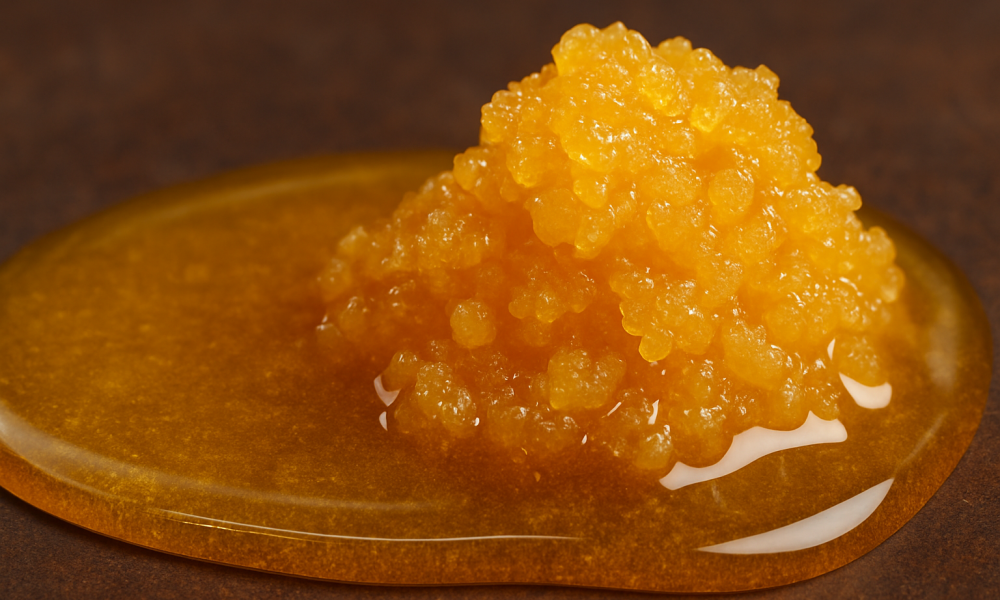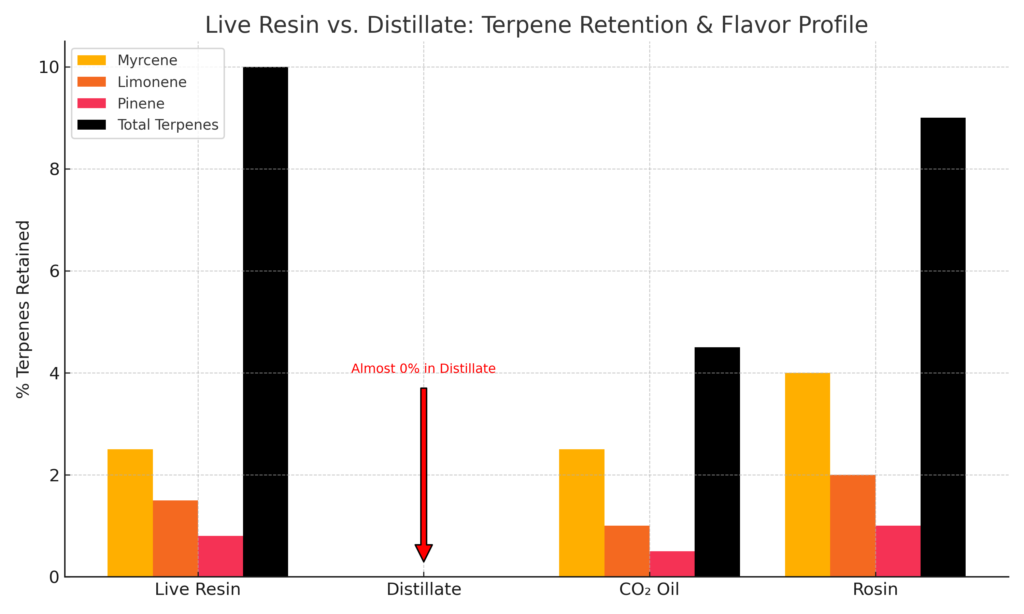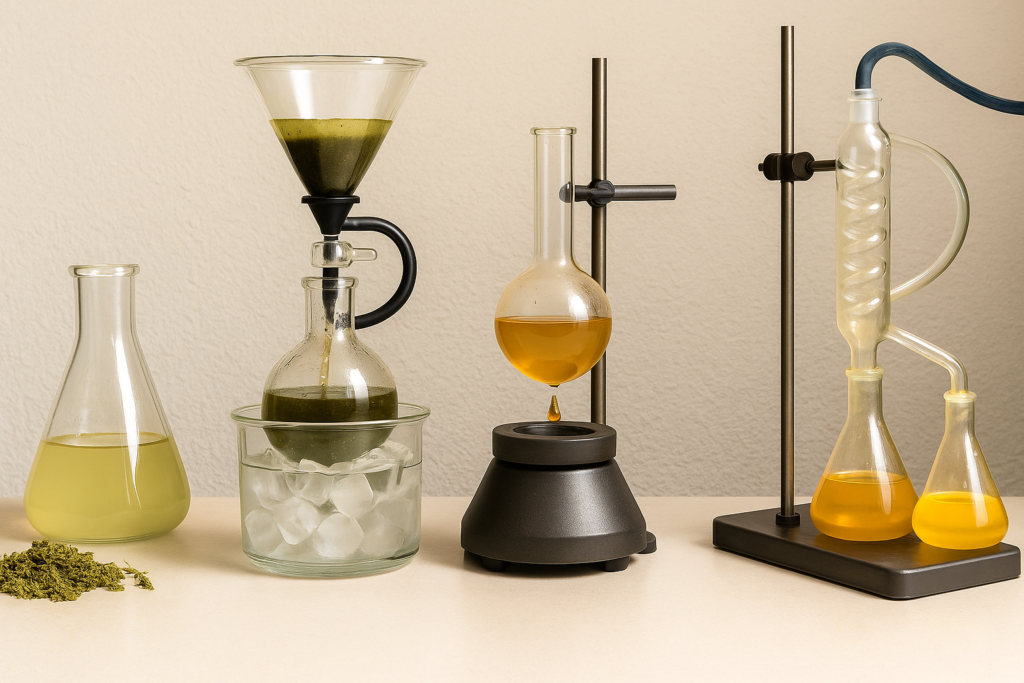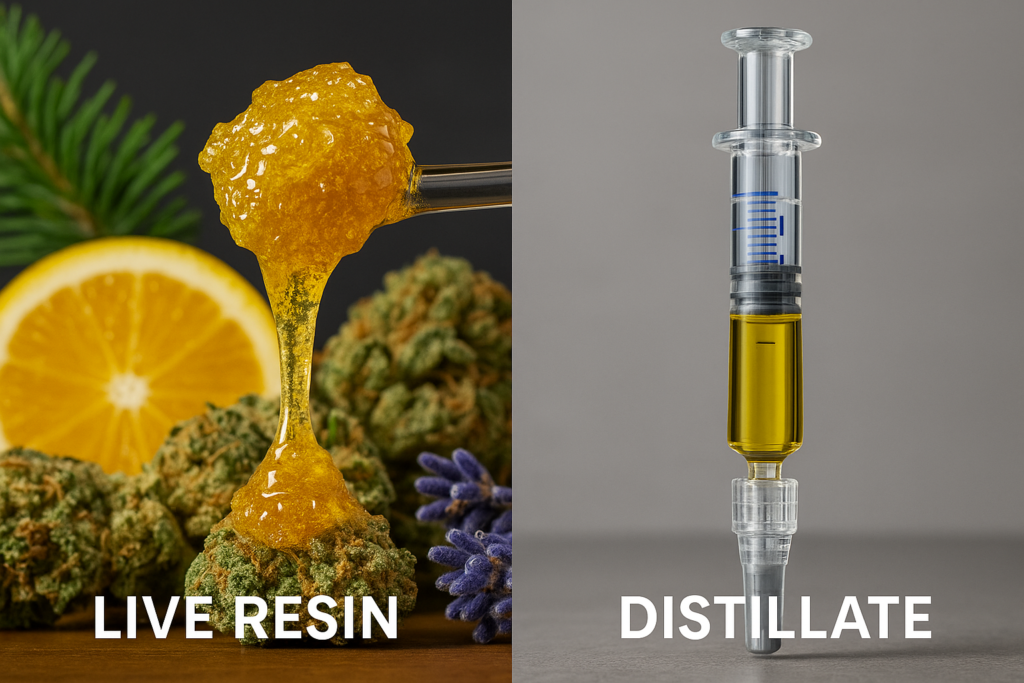Live Resin vs. Distillate: Which Cannabis Extract Rules 2025?

🌱Choosing the Best Cannabis Extract
If you’ve wandered into a dispensary or spent time browsing cannabis forums, you’ve probably heard this hot topic: Live Resin or Distillate — which one’s better?
It’s like debating your favorite ice cream flavor or coffee roast, but for your cannabis experience.
In 2025, this question matters more than ever. Consumers want more than just THC — they want flavor, aroma, therapeutic effects, and value. So, let’s unpack the story behind these two cannabis powerhouses, dig into how they’re made, how they make you feel, and why the industry can’t stop talking about them.
Ready to settle the debate? Let’s jump in!
🍯 What Is Live Resin? Unlocking the Freshest Cannabis Experience in a Jar
In the ever-evolving world of cannabis extracts, few products spark as much excitement—and confusion—as live resin. Often described as the “flavor king” of cannabis concentrates, live resin has become the go-to choice for both seasoned dabbers and terpene lovers seeking a richer, more aromatic experience. But what exactly is it, and why has it become such a buzzword in the cannabis space?
Let’s break it down: Live resin is all about preserving the living essence of the cannabis plant. Think of biting into a sun-ripened mango picked at peak ripeness—bright, juicy, unforgettable. Now compare that to a dried mango slice from a package. Still good, but something’s missing. That “something” is exactly what live resin captures in the cannabis world.
Whereas many extracts are made from dried and cured buds, live resin is created using fresh, uncured cannabis that is flash-frozen immediately after harvest. This technique preserves the terpenes (the compounds responsible for flavor and aroma) and the cannabinoid profile in its most vibrant, unaltered state.
❄️ How Is Live Resin Made? The Flash-Freeze Method That Changed the Game
The magic of live resin starts at harvest. Instead of drying and curing the cannabis—steps that can degrade delicate compounds—the plants are immediately flash-frozen at extremely low temperatures (as low as -40°F/-40°C). This process locks in the natural terpene and cannabinoid profile before any oxidation, degradation, or loss of potency can occur.
From there, the frozen flower undergoes a hydrocarbon extraction using butane, propane, or a blend of both solvents. What makes this process unique is that it’s conducted under cryogenic (super-cold) conditions, helping maintain the full terpene structure and prevent evaporation of volatile compounds.
The result? A sticky, aromatic concentrate often referred to as:
- Sauce
- Sugar
- Badder
- Live resin carts (when infused into vaporizer cartridges)
These forms all retain that true-to-strain flavor and aroma that traditional distillate or cured resins often lose during processing.
🌿 Why Should Cannabis Lovers Care About Live Resin?
Live resin is more than just hype—it represents a major step toward full-spectrum, whole-plant cannabis experiences. When you consume live resin, you’re not just getting THC or CBD; you’re consuming a chemical symphony of cannabinoids and terpenes working together to deliver what’s known as the entourage effect.
This effect describes how cannabinoids like THC, CBD, CBG, and others interact with terpenes like:
- Limonene (uplifting, citrusy)
- Myrcene (relaxing, earthy)
- Pinene (sharp, piney, helps focus)
When these elements are preserved in their raw, natural state—as they are in live resin—they produce more balanced effects, longer-lasting relief, and a significantly more nuanced experience than isolated THC.
In simple terms:
🧪 Distillate = pure THC.
🍊 Live resin = THC + full terpene flavor + enhanced effect.
For example, a sativa-dominant strain like Tangie processed as live resin will retain its bright citrus nose and mood-lifting energy. Process the same strain into distillate? You might get the THC, but not the vibe.
📊Live Resin and Terpene Retention
Back in 2024, a peer-reviewed study published in Frontiers in Plant Science analyzed terpene retention across several cannabis extract methods. Researchers found that live resin retained up to 95% of the original terpene profile of the plant, including volatile monoterpenes like beta-pinene and linalool—compounds typically lost during drying or high-heat extraction.
In contrast, distillate products retained less than 20% of original terpenes, unless synthetic or cannabis-derived terpenes were added back post-extraction. The takeaway? Live resin delivers a more faithful representation of the strain’s chemical fingerprint, making it ideal for both recreational connoisseurs and medical patients seeking precise effects.

💡 Why Budtenders and Dabbers Are Obsessed with Live Resin
Ask any experienced budtender or veteran dabber, and they’ll likely rave about live resin for one simple reason: it tastes like the plant it came from.
Here’s what some consumers have to say:
“I tried a live resin cart of Gelato 33 and it actually tasted like sweet, creamy fruit—not just generic weed vapor. The high was clear, chill, and happy, not like the dizzy rush I get from pure distillate.”
“I dab live resin before bed. The flavors make the whole ritual more enjoyable, and the body high melts away my stress better than anything else.”
In a market that’s saturated with products promising high THC percentages, **live resin stands out by offering a complete cannabis experience, not just a number on a label.
🧠 Pro Tip for Buyers: What to Look For in Live Resin Products
If you’re shopping for live resin, here are a few quality cues to keep in mind:
- ✅ Single-source: The flower and extraction happen from the same batch and grower—better quality control and terpene consistency.
- ✅ Cold-cured or cryo-extracted: Indicates proper handling and minimal heat exposure.
- ✅ Color and texture: Should appear golden, amber, or translucent with a syrupy or crystal-sugar-like consistency (depending on the form).
- ✅ Lab-tested: Make sure there are third-party COAs (Certificates of Analysis) showing terpene content and residual solvent levels.
And most importantly—ask about the terpene profile. A well-made live resin should be able to list the dominant terpenes and their effects.
🔬 Distillate Demystified: The Potent, Clean, No-Frills Cannabis Concentrate
While live resin gets all the hype for its loud flavors and “true to flower” experience, there’s another contender quietly dominating the cannabis extract world: distillate. If live resin is a fine wine with complexity and nuance, distillate is the pharmaceutical-grade spirit—clean, pure, and incredibly potent.
Distillate is often referred to as the “workhorse” of cannabis concentrates. It’s odorless, tasteless, and highly adaptable, making it the base ingredient for countless cannabis products like vape carts, edibles, capsules, and topicals. Its rise in popularity isn’t about flair—it’s about precision, control, and scalability.
⚗️ How Is Distillate Made?
The journey of cannabis distillate begins not with fresh-frozen flower, like live resin, but with dried and cured cannabis biomass—often trim or shake, but sometimes quality flower depending on the desired end-product. Here’s the step-by-step breakdown:
- Solvent Extraction
The starting material is soaked in a solvent—commonly ethanol, butane, or supercritical CO₂—to strip away cannabinoids and other compounds. The result is a crude cannabis extract, which still contains fats, lipids, chlorophyll, and waxes. - Winterization
This step is crucial for refining the crude oil. It’s mixed with alcohol and chilled to sub-zero temperatures to precipitate out fats and waxes. The mixture is then filtered to remove these impurities, resulting in a more purified oil. - Decarboxylation
The purified oil is heated in a controlled environment to activate cannabinoids—converting THCA to THC and CBDA to CBD. This is essential for psychoactivity and therapeutic effects. - Short-Path Distillation (Vacuum Distillation)
Finally, the oil undergoes short-path vacuum distillation, a process that uses controlled heat and vacuum pressure to separate specific cannabinoids. This produces a highly purified extract, often reaching 90–99% THC or CBD, depending on the goal.

At the end of this process, what’s left is a clear, viscous, golden oil—nearly devoid of flavor, aroma, and most minor cannabinoids and terpenes.
🤔 What’s the Catch? The Trade-Offs of Ultra-Purity
While distillate is powerful and versatile, it’s also stripped of much of the cannabis plant’s natural personality. Because the extraction and refinement process removes terpenes, flavonoids, and many minor cannabinoids, the resulting oil is often referred to as “cannabinoid isolate”—it delivers THC or CBD in a highly purified form, but lacks the entourage effect that full-spectrum products like live resin provide.
In fact, unless terpenes are added back in—either from cannabis-derived or botanical sources—the experience of consuming distillate can feel flat, generic, or “clinical.” It provides a powerful high, but one that some users describe as one-dimensional.
🔬 What Science Says About Distillate vs. Full-Spectrum Extracts
According to a 2023 study in the Journal of Cannabis Research, patients using full-spectrum cannabis extracts reported greater relief from pain, anxiety, and insomnia than those using THC-only distillate. The study supported the theory of the entourage effect, where multiple cannabinoids and terpenes work synergistically to enhance therapeutic outcomes.
Yet, that doesn’t make distillate irrelevant—it simply highlights the importance of matching the product to the purpose.
💡 When Is Distillate the Best Choice?
Distillate’s simplicity is its superpower. Here’s when it truly shines:
- ✅ Edibles & Gummies: Distillate’s lack of flavor and precise potency make it ideal for infusion into chocolates, baked goods, or beverages without altering taste.
- ✅ Topicals & Capsules: It offers clean, predictable cannabinoid content for transdermal or ingestible products, where flavor and aroma are irrelevant.
- ✅ Budget-Conscious Formulations: For large-scale producers, distillate is more cost-effective than terpene-rich extracts and offers longer shelf life.
- ✅ Custom Vape Formulas: Brands can control every aspect—THC % + flavor + aroma—by adding terpenes back in or blending with minor cannabinoids like CBN, CBG, or THCV.
- ✅ Microdosing & Medical Use: With its consistent cannabinoid profile, distillate is useful for patients who need precise, repeatable dosing.
📦 Why Brands Love Distillate
From a B2B perspective, distillate is the backbone of the cannabis industry’s product diversity. It allows manufacturers to:
- Create standardized products across batches
- Use versatile formulations for multiple SKUs (vapes, gummies, oils)
- Meet strict regulatory demands for purity and labeling
- Keep production costs low while maintaining high THC content
It’s no wonder that over 65% of vape cartridges sold nationally still use distillate as the primary extract (BDSA, 2024).
🧪 Distillate in Action
Imagine a cannabis brand launching a “Lite Buzz” low-dose gummy line aimed at beginners. They choose THC distillate because:
- It’s neutral in taste, letting fruity flavors shine
- It allows precise 2.5mg or 5mg doses
- It’s shelf-stable and easy to mass-produce
🎢 Live Resin vs. Distillate: Flavor Bomb or Pure Power?
When it comes to cannabis extracts, the difference isn’t just in how they’re made—it’s in how they make you feel. Whether you’re a casual dabber, a vape connoisseur, or a medical patient, the user experience between live resin and distillate is like night and day. Let’s break it down.

🔬 Live Resin: Terpenes That Shape the High:
Live resin is loaded with terpenes like:
- Myrcene – Calming and sedative, often found in Indica-dominant strains
- Limonene – Uplifting and mood-enhancing; great for stress relief
- Pinene – Promotes alertness and mental clarity, balances out THC’s fogginess
- Caryophyllene – Anti-inflammatory and grounding, works on CB2 receptors
These terpenes not only create that signature “live” aroma—think citrus peels, pine forests, sweet gas—but also modulate the psychoactive effects of THC, making the experience more balanced, enjoyable, and strain-specific.
If you’re vaping a live resin made from a strain like Blue Dream, expect an uplifting cerebral buzz that slowly melts into body calm, with a fruity, herbal inhale that mirrors the flower’s original essence.
For many users, this makes live resin feel more natural, expressive, and personalized, like you’re actually tasting the plant—not just getting high from it.
⚡️ Distillate’s Kick: Pure Potency Without the Personality
Now let’s flip the coin.
Distillate is the powerhouse of purity—stripped of almost everything except for THC (or CBD, depending on the extract). The result is a high-potency, highly consistent concentrate that delivers what many call a “clinical high”: quick onset, strong head change, and straightforward effects.
Since most of the natural terpenes are lost during distillation, some products reintroduce terpenes (either cannabis-derived or synthetic) to add back flavor or desired effects. But even then, it often lacks the full-spectrum depth and subtlety of live resin.
💬 How It Feels:
- The high can feel fast, sharp, and short-lived.
- Great for immediate relief from pain, anxiety, or sleeplessness.
- Can be ideal for medical patients, or for those who want to measure exact doses without unpredictable effects.
A distillate vape pen with 95% THC might hit you like a freight train—especially if you’re newer to cannabis—but the experience might feel more one-dimensional, like a single note played loudly instead of a full melody.
From Reddit to dispensary reviews, the contrast in experience between live resin and distillate is a recurring theme:
💬 “Live resin carts taste like the flower I love, and the high feels more natural. Distillate carts hit hard but feel kinda flat after a while.”
— @VapeQueen420
💬 “I use distillate during the day when I need clean focus and no couchlock. Live resin is my go-to for chill evenings—it’s like aromatherapy with a buzz.”
— @DabDad420
This feedback reflects a wider consumer trend: people are starting to see cannabis not just as a THC delivery method, but as a full sensory experience.
| Feature | Live Resin | Distillate |
| Flavor | Bold, fresh, full-spectrum; strain-specific | Mild or artificial (if terpenes added) |
| Experience | Euphoric, balanced, more “natural” | Powerful, quick, sometimes short-lived |
| Best Use Case | Flavor-focused consumers, connoisseurs, nighttime use | Daytime microdosing, edibles, medical patients |
| High Profile | Layered and complex (thanks to terpenes) | Pure THC effect—strong but often generic |
🔬 How They’re Made and Why It Matters
Live Resin Extraction:
- Step 1: Harvest and flash-freeze fresh cannabis
- Step 2: Extract with cold butane/propane preserving terpenes
- Step 3: Purge solvents carefully at low temps
- Step 4: Result is “sauce” or “sugar” rich in cannabinoids and terpenes
Distillate Extraction:
- Step 1: Use cured flower or trim for ethanol or CO₂ extraction
- Step 2: Winterize oil to remove lipids and waxes
- Step 3: Decarboxylate cannabinoids (activate THC/CBD)
- Step 4: Short-path distillation to isolate pure cannabinoids
| Feature | Live Resin | Distillate |
| Terpene Retention | Very High (~95%) | Low (<20%), often added back |
| Cannabinoid Spectrum | Full-spectrum | Mostly isolated THC/CBD |
| Flavor & Aroma | Bold, plant-like | Neutral or artificial |
| Potency (THC) | ~60–80% | 90–99% |
| Production Scale | Small batch, craft | Mass production |
📈 2025 Market Trends: What Are Cannabis Consumers Really Buying?
Consumers today want more than just potency—they want flavor, wellness, and an experience.
Live Resin Is On Fire:
- Live resin SKUs grew 31% year-over-year in 2024
- High terpene extract (HTE) vape carts now represent nearly 20% of vape sales in California
- Younger adults (25–40) show rising loyalty to terpene-rich extracts
Distillate Holds Its Ground:
- Still makes up 65% of vape cartridges sold nationwide
- Backbone for edibles, tinctures, and topicals
- Budget-friendly and consistent
Wholesaler Tip:
Retailers report that despite higher prices, live resin products have higher repeat purchase rates and customer satisfaction.
🍽️ When Should You Pick Live Resin? When Does Distillate Win?
Live Resin: Perfect For
- Dabbers and flavor lovers
- Medical patients wanting full-spectrum benefits
- Anyone who appreciates the entourage effect
- Premium vape carts and boutique products
Distillate: Best For
- Edibles, capsules, and infused topicals
- Standardized dosing needs
- Budget-conscious buyers
- Brands scaling production with consistent potency
📊How One Colorado Dispensary Made Live Resin Their Bestseller
Green Cloud Dispensaries launched an HTE live resin vape line in early 2024 alongside their existing distillate carts. Despite being 25% more expensive, the live resin line outsold distillate 3-to-1 within two months.
Customers raved about:
- The authentic flavor
- A longer-lasting, balanced high
- The connection to favorite strains
Sales data showed better customer retention and word-of-mouth referrals, proving premium concentrates are worth the investment.
🧠 Cannabis Extract Lingo 101: Terms You Should Know
| Term | What It Means |
| HTE (High Terpene Extract) | Extract with naturally high terpene content, like live resin |
| Entourage Effect | Synergistic effect of cannabinoids and terpenes together |
| Decarboxylation | Heating cannabinoids to activate their effects |
| Winterization | Process removing fats/waxes from crude extracts |
| Short-Path Distillation | Vacuum distillation that isolates cannabinoids |
| Flash-Freezing | Immediate freezing of harvested plants to preserve terpenes |
| Cannabis-Derived Terpenes | Terpenes extracted from cannabis plants, not synthetic |
| Dabbing | Vaporizing concentrates by heating on a hot surface |
| Sugar Sauce | Live resin form with crystals and terpene-rich liquid |
| Isolate | Pure cannabinoid without terpenes or other compounds |
🔧 Pro Tips for Choosing and Selling Extracts
For Beginners:
- Start with live resin disposables to enjoy flavor without complexity
- Ask budtenders for terpene profiles and lab results
- Avoid vape carts with added synthetic terpenes unless you like candy flavors
For Wholesalers & Retailers:
- Educate staff about entourage effect and terpene profiles
- Stock both premium live resin and cost-effective distillate options
- Use in-store signage to highlight differences and guide consumers
🎉 Which Extract Takes the Crown?
There’s no single winner here—it’s all about what you want from your cannabis experience.
- Love flavor, aroma, and nuanced effects? Live resin is your go-to.
- Need pure potency, consistency, and affordability? Distillate is still king.
In 2025, the cannabis market celebrates both—and consumers benefit from choice like never before.
🛒 Ready to Stock the Best Extracts for Your Customers?
Wholesalers, growers, and retailers—explore our curated selection of premium live resin and high-quality distillate products.
👉 Visit Our Shop Page Now!
💬 Join the Conversation!
Which cannabis concentrate is your favorite—live resin’s flavor explosion or distillate’s pure power? Share your story and questions below!
